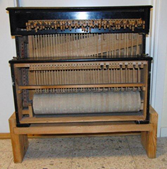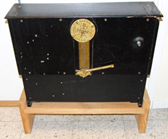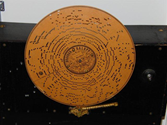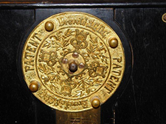Dumb organist (försättare), Ludwig Hupfeld, c 1897, KH 560
Among our self-playing instruments is a small dumb organist of unusual construction (KH 560). The black-painted box is not large, height 60 x width 70.5 (both excluding lid) x depth 17/18/11 cm, but judging by the threaded holes on the underside has originally had some form of stand or legs, which adjusted to the height of the mechanism in relation to the keyboard it is to be played against. In the middle of the front there is a mechanism for perforated music discs of Paul Ehrlich’s patented type and diagonally to the right of it is a bracket for a crank. The mechanism has “fingers” for 42 keys, of which 36 are audible and 6 mute. The power from the crank is transmitted by a perforated belt to a cloth-covered roller, against which the fabric-covered trackers rest at the bottom so that friction occurs and the roller moves around. Compared to the Phonola model, which was launched in 1901, this one has a significantly simpler construction and should be older than this one.
With serial number 2709, the small device can hardly be Swedish, but its origins should be sought abroad. Initially, thoughts go to Leipzig, which between the years 1880 and 1920 was a significant center for the manufacture of self-playing instruments. Countless varieties of music disc following the punched card principle dominated ca. 1880-ca. 1900, while the period ca. 1900 to ca. 1920 was the time of the autopiano and other music machines. Our example has a mechanism from Ehrlich’s 1885 patent, but did he make the device itself, or did he sell the mechanism to others who built it into their own cases?
Three factories are at the center of our interest in early punched-card disc-controlled dumb organists – “J.M. Grob” (active from 1880, d. 1891) with its Clavier-Spieler from 1887, “Fabrik Leipziger Musikwerke vormals Paul Ehrlich” (factory active 1877-1905) with its Clavier-Automat which also began to be manufactured in 1887, and Ludwig Hupfeld ( the factory active from 1892, when Grob’s firm was bought, to 1945), with its Klavierspieler. If one studies their different models, the conclusion is that our converter should come from Hupfeld and be made between 1892 and the beginning of the 20th century, when he developed the ‘Phonolan’ in 1901. Ehrlich’s model is narrower and has the disc on the far left of the device, while Grob and Hupfeld’s automata have great similarities between themselves. However, there is the difference that Grob attaches his mechanism at the bottom, while Hupfeld extended his automaton at the bottom, so that the mechanism appears to be located in the middle of the device. In other words, Hupfeld has built on Grob’s model, which may explain why he kept the name Klavierspieler.



